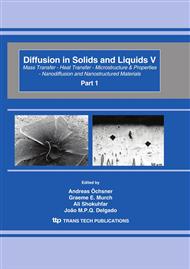[1]
Y. Fukai and N. Ōkuma: Jpn. J. Appl. Phys. Vol. 32 (1993), p. L1256; Phys. Rev. Lett. Vol. 73 (1994), p.1640.
Google Scholar
[2]
Y. Fukai: J. Alloys Comp. Vols. 356-357 (2003), p.263.
Google Scholar
[3]
Y. Fukai, The Metal Hydrogen System, 2nd Ed., Springer, Berlin-Heidelberg, (2005).
Google Scholar
[4]
H. Noh, T.B. Flanagan, B. Corundolo, and A. Craft: Scripta Metall. 25 (1991), p.225; H. Noh et al.: Scripta Metall. Vol. 26 (1992), p.353.
Google Scholar
[5]
K. Watanabe, N. Ōkuma, Y. Fukai, Y. Sakamoto, and Y. Hayashi: Scripta Mater. Vol. 34 (1996), p.551.
Google Scholar
[6]
E. Hayashi, Y. Kurokawa, Y. Fukai: Phys. Rev. Lett. Vol. 80 (1998), p.5588.
Google Scholar
[7]
Y. Yamazaki, H. Kakuta, M. Okada, and Y. Iijima: Defect Diff. Forum, Vols. 194-199 (2001).
Google Scholar
[8]
H. Koike, Y. Shizuku, A. Yazaki, and Y. Fukai, J. Phys.: Condens. Matter Vol. 16 (2004), p.1335.
Google Scholar
[9]
T. Iida, Y. Yamazaki, T. Kobayashi, Y. Iijima, and Y. Fukai: Acta Mater. Vol. 53 (2005), p.3083.
Google Scholar
[10]
P. Ehrhart, P. Jung, H. Schultz, and H. Ullmaier, Atomic Defects in Metals, H. Ullmaier (Ed. ), Landolt-Bornstein, New Ser., Springer, Berlin-Heidelberg, (1991).
Google Scholar
[11]
S.M. Myers, P.M. Richards, W.R. Wampler, and F. Besenbacher: J. Nucl. Mater. Vol. 165 (1989), p.9.
Google Scholar
[12]
M. Iwamoto and Y. Fukai: Trans. JIM Vol. 40 (1999), p.606.
Google Scholar
[13]
H. Kasai, T. Kawauchi, Y. Fukai, X. -W. Zhang, S. Kishimoto, T. Kikegawa, E. Ohtani, and T. Okano: Appl. Surf. Sci., in press.
Google Scholar
[14]
Y. Fukai, M. Mizutani, S. Yokota, M. Kanazawa, Y. Miura, and T. Watanabe: J. Alloys Comp. Vols. 356-357 (2003), p.270.
DOI: 10.1016/s0925-8388(02)01270-7
Google Scholar
[15]
S. Nakahara, S. Ahmed, aand D.N. Buckley: Electrochem. Solid-State Lett. Vol. 10 (2007), p. D17.
Google Scholar
[16]
D.S. Stoychev, I.V. Tomov, and I.B. Vitanova: J. Appl. Electrochem. Vol. 15 (1985).
Google Scholar
[17]
N. Mukaibo, Y. Shimizu, Y. Fukai, and T. Hiroi: Materials Trans. Vol. 49 (2008), p.2815.
Google Scholar


